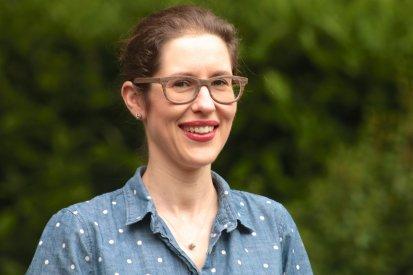Tell us about your research in the Department of Germanics.
My research interests include medieval and early modern German and Yiddish literature, and pre-modern cultural transfers within a German-Jewish context as well. I have published on old Yiddish literature, early modern marriage treatises, and most recently on a German graphic novel.
A lot of my recent projects were related to a German-Yiddish story tradition around an Arthurian knight called Wigalois / Viduvilt, respectively. He is the son of the better-known Sir Gawein. In that context, I have dealt with translations, transliterations –and, sometimes, texts that present a hybrid form– a lot, in addition to ideas of translating words into images and vice versa, a topic that is particularly relevant for the illuminated medieval manuscripts I have been working with.
How do you use Translation Studies in your classes?
I’m teaching mostly classes on medieval literature, sociolinguistics, and a variety of German language classes for the Department of Germanics, at both undergraduate and graduate level. Naturally, translation is a big topic when it comes to the literature I assign. Although graduate students are not required to know Middle High German for my class, I bring in some untranslated material to give them an idea of the original tone, and the relation between medieval and modern German.
In the linguistics classes, students can often re-create relations among the Germanic languages by looking at different translations of texts such as the Lord’s Prayer, which was translated early on in many languages to boost Christian missionizing efforts as one part of geo-political expansion.
A reoccurring topic in my classes is untranslatability and the limitations that arise from accessing material through translations. A concrete daily example is one word that students thoroughly enjoy and often remember: verschlimmbessern. The word comes originally from the field of manuscript preservation, and means that in an attempt of preserving a severed artifact, it gets ruined rather than improved, often with the sad result of parts of a text being rendered illegible. The word perfectly captures the universal feeling that occasionally we make something worse when attempting to improve it!
How did you become interested in the Translation Studies field?
A lot of my work relates to Translation Studies. However, I only really started exploring the broad field of translation theory when trying to capture the essence of a 17th-century textbook for Yiddish-learners: Belehrung der Jüdisch-Teutschen Red- und Schreibart [Introduction to Written and Spoken Jewish-German] (1699), by the Protestant philosopher and Hebraist Johann Christoph Wagenseil (1633–1705). It’s a reprint of an Arthurian tale (Yosl Alexander ben Witzenhausen’s Artis Hof) in Old Yiddish. Being a textbook, it also offers a “German” version as facing-page equivalent to the Yiddish. A closer look at the “German” text reveals that Wagenseil made significant interpretative choices such as using different typefaces to mark Germanic and Hebrew language elements in Yiddish. The result is a hybrid translation-transliteration that is supposed to teach Yiddish to German-speakers, ideally as a first step on their way to learn Hebrew. And Yiddish-speakers who wanted to learn German were a secondary audience.
Tell us about your forthcoming translation of an Arthurian tale.
The article that is set to appear in Arthuriana later this year offers the first English-language translation of Sir Gabein, a hitherto unknown 18th-century Yiddish tale about Sir Gawein, in which the Arthurian knight becomes the Emperor of China. I am very excited to make this text accessible to a broader audience. The translation proved very challenging since the text is only preserved as transliteration in an appendix to Leo Landau’s Arthurian Legends or the Hebrew-German Rhymed Version of the Legend of King Arthur (1912).
The Yiddish HISTORIE oder moralische erzehlung handelt von wunder-bahre begebenheiten eines jungen RITER GABEIN worous di getliche vor-sehung erkant wert [History or Moral Tale about a Young Sir Gabein’s Marvelous Adventures Illustrating Divine Providence] (1788/89) extents the geopolitical (and concomitant ritual and religious) scope of the Arthurian world and re-envisions the Arthurian knight as a cosmopolitan hero. The adaptation combines contemporaneous sinophilia with colonialist fantasies, and ultimately places an Arthurian knight on the imperial throne of China. The global reach of this adaptation and its cosmopolitan hero illustrates—even more than the previously discussed texts—intercultural encounters both within the narrative and within its form, and its transmission history.
What translated work are you reading currently / read recently?
Oh, so many! I just read a translation of the Old Norse Saga of the Völsungs, with my graduate students in a class on medieval epics. Together with my husband, I am currently daily reading Eric Carle’s all-time classic The Very Hungry Caterpillar in Spanish and German translation to our little daughter.
And just yesterday I listened to the first chapter of the Yiddish translation of Harry Potter and the Philosopher’s Stone, read by its translator, Arun Viswanath. Dumbledore sounds charming in Yiddish! You can listen to it for free here: https://forward.com/yiddish/444636/listen-to-the-first-chapter-of-harry-potter-in-yiddish/.
---------------------------------------------------------------------------------------------------------------------------------------------------------------
Annegret Oehme is an Assistant Professor in the Department of Germanics and affiliate professor with the Stroum Center for Jewish Studies. Her most recent publication is a short-form monograph that explores the construction of female agency in German and Yiddish Arthurian stories about Gawein’s son (‘He Should Have Listened to His Wife’, de Gruyter, 2020).
----------------------------------------------------------------------------------------------------------------------------------------------------------------
This interview by Jesús Hidalgo with Annegret Oehme is part of the #UWtranslators series of interviews with translators by the UW Translation Studies Hub at the Simpson Center.
